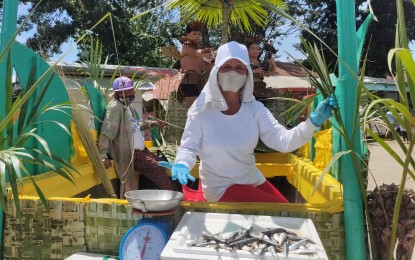
BARANGAY FEST. A sardine vendor in Barangay Bonbon, Cagayan de Oro City, joins the float parade as the village celebrates the "TambaNipa" Festival on Friday (Sept. 9, 2022). The celebration is a reminder that the coastal barangay is a rich source of sardines and nipa palms. (PNA photo by Ercel Maandig)
CAGAYAN DE ORO CITY – The coastal community of Barangay Bonbon here once prides itself as a rich source of sardines where the species thrived because of the dense nipa (Nypa fruticans) palms thriving in the area.
This is why the barangay (village) council sought to bring back its display of marine abundance and be reminded of their village's identity through the revival of the "TambaNipa" festival on Friday.
The festival started in 2002, with Bonbon as the first barangay in the city to institutionalize a local festival.
"TambaNipa" is a portmanteau of "tamban," the vernacular word for sardines, and "nipa," a variety of mangrove palm that covers the barangay's coastal zone.
However, the annual celebration stopped for two years following the coronavirus disease 2019 pandemic in March 2020. Synonymous was the small catch of fishermen even during the sardines season.
In an interview Friday, village chairperson Allan Mabalacad said the sardine season usually begins between August and September, a time when the village comes alive as fishermen busily attend to their generous catch.
This time might be different, however, as villagers observed that the sardines aren't keeping up with the season.
During the TambaNipa launching Friday, only one fisherman managed to catch the "obligatory" one-kilo sardines.
"Fishermen used to be merrier in this time of the year celebrating with lechon on their tables, but not so much this year due to fewer catch," resident Maryjane Daba noted.
"It's been a year since sardines did not appear on many of our coastlines in Macajalar Bay, the last time was in August of 2021," she said.
Daba said when sardines are in abundance, these would only cost PHP10 to PHP30 per kilo, but are currently sold at PHP80 to PHP100 per kilo.
According to the Bureau of Fisheries and Aquatic Resources (BFAR) in Northern Mindanao, sardines manufacturing plants nationwide are contemplating on halting their operations due to the lack of sardines supply in the country.
The agency has started its investigation into the causes of catch decline of sardines, especially in Macajalar Bay.
BFAR-10 Director Teodoro Bacolod said one possible cause of the decline of sardine yield is illegal fishing, which uses small fish nets with pockets that would catch even the sardine fry.
In the meantime, the revived TambaNipa Festival in Barangay Bonbon is attempting to boost the residents' morale with a street dancing competition, featuring props and costumes made from fishing nets and nipa grass.
Float parades are also in competition for the first time, followed by a dance showdown with Festival King and Queen contest.
The floats were decorated with nipa leaves, and fishing gears, where creativity takes control to get winning prizes, which can somehow cope with the meager income of most fishermen in the village at the moment. (PNA)
